Mediterranean salads are a colorful mix of fresh ingredients and simple dishes from the Mediterranean. They include crisp cucumbers, zesty oranges, hearty potatoes, and sweet watermelon. You’ll love recipes like Fattoush Salad, Mediterranean Black Bean Salad, and Beet Salad with Shallot Mandarin Vinaigrette.
These salads are not just tasty. They also follow the Mediterranean diet, which is good for your heart and can lower disease risk.
Key Takeaways : Mediterranean Salad
- Mediterranean salads feature a vibrant array of fresh, wholesome ingredients
- These salads align with the Mediterranean diet, known for its health benefits
- Popular recipes include Fattoush Salad, Mediterranean Black Bean Salad, and Beet Salad
- Mediterranean salads offer a balance of flavors, from zesty to sweet and earthy
- Incorporating Mediterranean salads into your diet can support overall health and well-being
The Rich Heritage of Mediterranean Cuisine and Its Health Benefits
Mediterranean cuisine has deep roots in ancient civilizations around the Mediterranean Sea. The area’s climate and geography made it rich in fresh veggies, fruits, herbs, and olive oil. These ingredients are still key in Mediterranean recipes today. Over time, salad recipes in the Mediterranean have grown and changed, influenced by local ingredients and cultural exchanges.
The Mediterranean diet focuses on plant-based foods, healthy fats, and lean proteins. It’s known to boost heart health, lower the risk of chronic diseases, and support overall health. Mediterranean dishes are famous for their moderate dairy, wine, and olive oil use, reflecting the region’s culinary traditions.
Mediterranean dishes are full of fruits, vegetables, whole grains, legumes, nuts, seeds, lean fish, poultry, and dairy proteins. The region’s food is rich in antioxidants, fiber, vitamins, and anti-inflammatory compounds. This makes it a favorite among those who care about their health.
“The Mediterranean diet is consistently recognized by research for enhancing overall wellness and longevity.”
From Southern Europe to the North African coast and the Eastern Mediterranean, the Mediterranean’s culinary stories have merged. This has created a diverse and lively food scene. This heritage continues to inspire and delight food lovers worldwide, offering a tasty and healthy way to eat.
Mediterranean Salad: Essential Ingredients and Preparation Tips
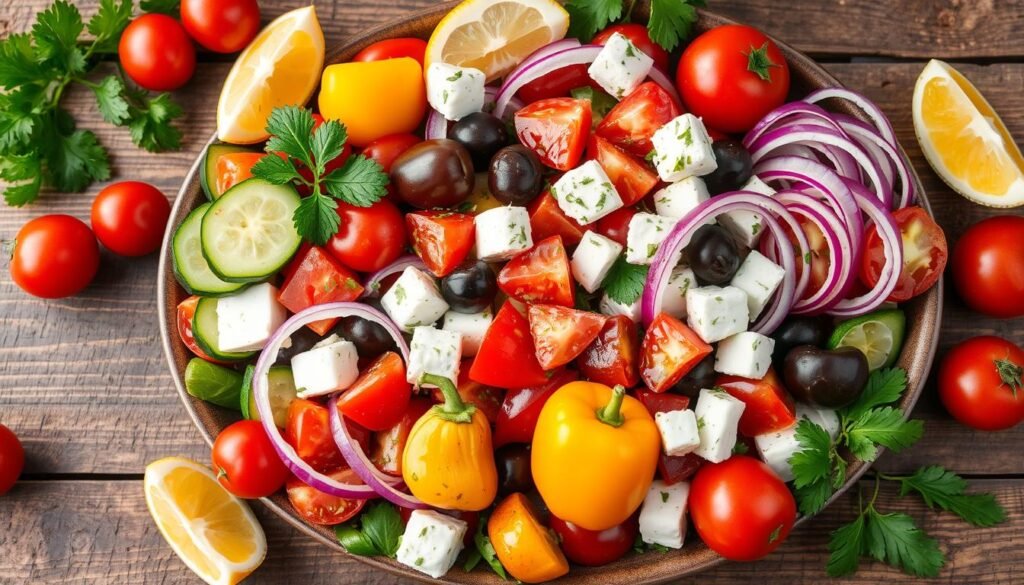
A great Mediterranean salad starts with fresh, vibrant ingredients. It’s all about the olive oil for healthy fats, the fresh herbs for aroma, and the produce for color. With these elements and some simple preparation techniques, you can make a salad that looks good and tastes amazing.
Core Mediterranean Ingredients
The Mediterranean diet is known for its fresh veggies, fruits, and legumes. Start with crisp lettuce like butter, iceberg, or romaine. Add chopped veggies like juicy tomatoes, crunchy cucumbers, and zesty red onions. You can also add chickpeas, white beans, or grilled meats for more protein.
Fresh herbs like parsley, mint, basil, and oregano are key. They add a fragrant, herbal flavor to every bite.
Basic Preparation Techniques
- Use the freshest, seasonal produce for the best taste and nutrition.
- Make a simple dressing with olive oil and lemon juice. This lets the natural flavors of the ingredients shine.
- Add a sprinkle of feta cheese or olives for a true Mediterranean flavor.
- Let the salad rest for a few minutes before serving. This lets the flavors mix well.
By using these ingredients and techniques, you can make a Mediterranean salad that looks great and tastes fantastic. It’s perfect for a light lunch or a refreshing side dish. It will take your taste buds on a trip to the Mediterranean.
Classic Mediterranean Salad Variations
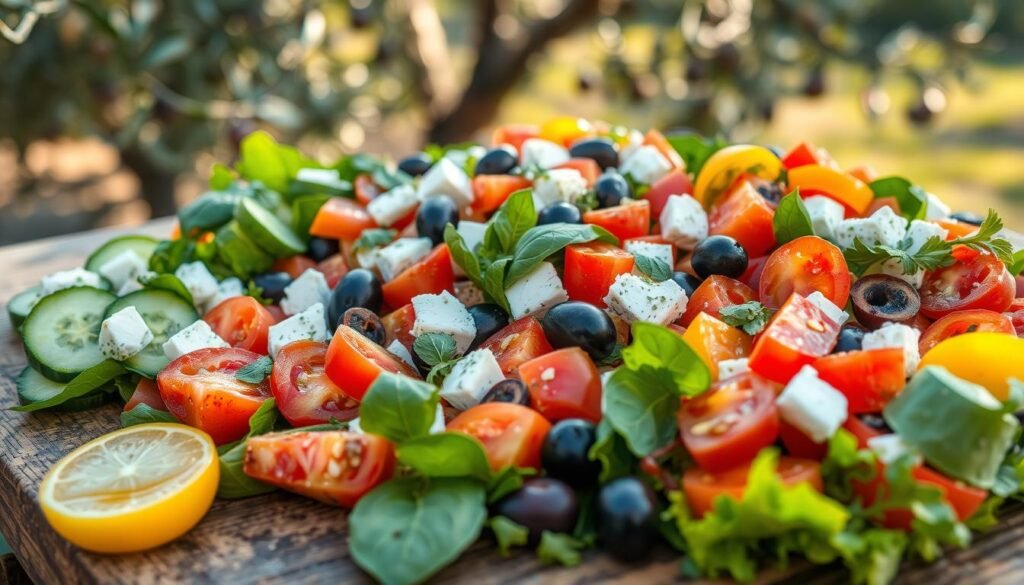
The Mediterranean region is known for its delicious salads. Each salad highlights the area’s diverse ingredients and cooking traditions. For example, the Greek salad (Horiatiki) has ripe tomatoes, crisp cucumbers, pungent olives, and creamy feta cheese. The Caprese salad is a favorite, with its juicy tomatoes and fresh mozzarella.
The Tabbouleh from Lebanon is another hit. It’s made with finely chopped parsley, bulgur, and juicy tomatoes. The Fattoush salad also comes from Lebanon. It has toasted pita bread, adding crunch to the mix of greens, vegetables, and tangy dressing.
There are many more Mediterranean salads to try. The French Nicoise salad combines tuna, hard-boiled eggs, and potatoes. The Cucumber Yogurt Salad is refreshing, while the Grilled Shrimp Salad from Spain is a seafood lover’s dream. These salads show the wide range of Mediterranean flavors and traditions.
| Salad Variation | Key Ingredients | Origin |
|---|---|---|
| Greek Salad (Horiatiki) | Tomatoes, cucumbers, olives, feta cheese | Greece |
| Caprese Salad | Tomatoes, mozzarella, basil | Italy |
| Tabbouleh | Parsley, bulgur, tomatoes | Lebanon |
| Fattoush | Greens, vegetables, toasted pita | Lebanon |
| Nicoise Salad | Tuna, hard-boiled eggs, potatoes | France |
| Cucumber Yogurt Salad | Cucumbers, yogurt, herbs | Mediterranean |
| Grilled Shrimp Salad | Shrimp, greens, vegetables | Spain |
These classic Mediterranean salads celebrate the region’s vibrant flavors and culinary diversity. They invite you to explore the rich heritage of this delicious cuisine.
Modern Twists on Traditional Recipes
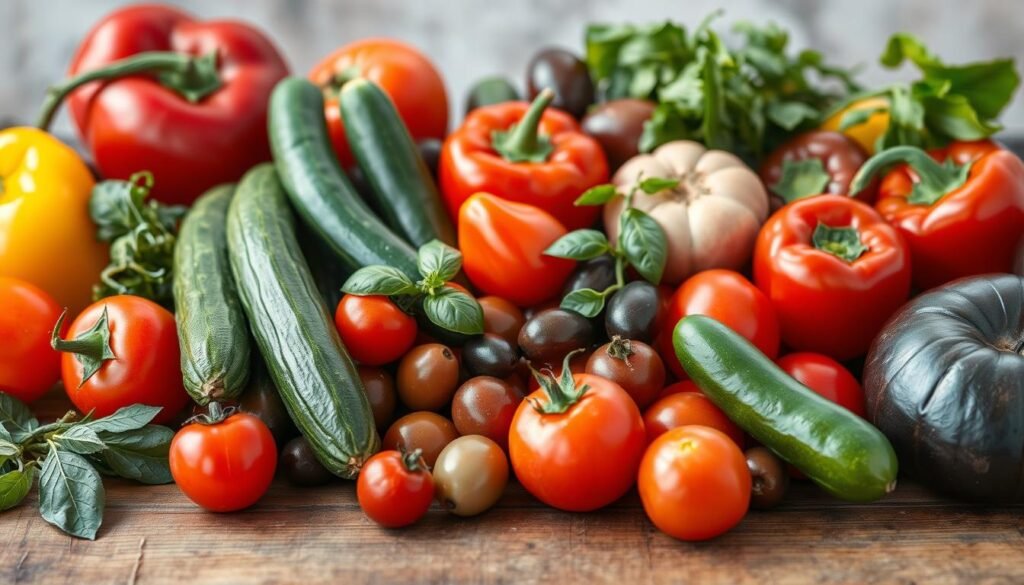
Mediterranean cuisine’s vibrant flavors and health benefits have won over food lovers everywhere. This has inspired chefs to put a fresh spin on classic salads. They keep the Mediterranean taste but add new ingredients and seasonal touches.
Contemporary Ingredients
Now, chefs mix Mediterranean favorites with trendy superfoods. For example, a Quinoa Salad with Feta, Olives & Tomatoes combines quinoa, feta, olives, and tomatoes. It’s a tasty mix of flavors and textures.
Another hit is the Kale Pomegranate Salad with Goat Cheese. It pairs kale, pomegranate arils, and goat cheese. This salad offers a great mix of earthy and tangy tastes.
Seasonal Adaptations
Chefs also love to use local produce in their salads. In winter, they might use roasted carrots, beets, and parsnips. Summer salads often feature berries, grilled zucchini, and halloumi cheese, as in the Halloumi and Watermelon Salad.
These changes let people enjoy Mediterranean flavors all year. They use the freshest ingredients available, making each salad unique.
These modern takes on Mediterranean salads show how versatile this cuisine is. Chefs and home cooks can create exciting dishes by using new ingredients and seasonal produce. This way, they meet changing tastes and dietary needs.
Also Read : Salad Innovations: Creative Salad Recipes To Spice Up Your Plate
Conclusion
Mediterranean salads are a tasty and healthy way to follow the Mediterranean diet. They use fresh, seasonal ingredients and simple recipes. This makes them both delicious and good for you.
By trying out Mediterranean salad recipes, you can enjoy many different flavors and textures. This supports a healthy lifestyle.
Mediterranean salads are great for anyone who loves to eat well. They mix traditional recipes with new ideas. This makes them a fun and healthy choice for any meal.
These salads are full of Mediterranean flavors and support sustainable farming. They add joy and nutrition to any meal.
The Mediterranean’s salad tradition is loved for its health benefits and taste. Adding these dishes to our daily meals brings the Mediterranean’s spirit into our lives. It also helps us stay healthy.
FAQs
Q: What is a Mediterranean salad recipe?
A: A Mediterranean salad recipe typically includes fresh vegetables, herbs, and a dressing made from olive oil and vinegar, often featuring ingredients like tomatoes, cucumbers, olives, and feta cheese.
Q: How can I make Mediterranean salad?
A: To make Mediterranean salad, combine fresh vegetables such as tomatoes, cucumbers, and red onions with olives and feta cheese. Dress the salad with extra virgin olive oil and red wine vinegar, then toss to combine.
Q: What are the key ingredients in a Mediterranean chopped salad?
A: Key ingredients in a Mediterranean chopped salad include chopped cucumbers, tomatoes, bell peppers, red onion, parsley, olives, and feta cheese, all dressed with olive oil and vinegar.
Q: Can you suggest a Mediterranean chickpea salad?
A: A Mediterranean chickpea salad can be made by mixing canned chickpeas with diced cucumbers, tomatoes, red onion, parsley, and a dressing of olive oil and lemon juice. This dish is nutritious and filling.
Q: What should I serve with a Mediterranean salad?
A: You can serve Mediterranean salad as a side salad alongside grilled chicken or fish, or it can be a main dish when paired with a protein like chickpeas or quinoa.
Q: What are the salad ingredients for a simple Mediterranean salad?
A: Salad ingredients for a simple Mediterranean salad typically include cucumbers, tomatoes, red onion, olives, and feta cheese, dressed with olive oil, lemon juice, and herbs.
Q: What is the best way to dress the salad?
A: The best way to dress the salad is to whisk together olive oil, red wine vinegar, salt, and pepper, then drizzle over the salad ingredients before tossing gently to coat evenly.
Q: What makes a great everyday Mediterranean salad?
A: A great everyday Mediterranean salad includes a variety of fresh vegetables, a balanced dressing, and can easily incorporate proteins like chickpeas or grilled chicken for added nutrition.
Q: How do I make a Mediterranean cucumber salad?
A: To make a Mediterranean cucumber salad, slice English cucumbers and combine them with diced tomatoes, red onion, parsley, and a dressing of olive oil and vinegar. Toss the salad before serving.
Q: What is a popular tomato salad in Mediterranean cuisine?
A: A popular tomato salad in Mediterranean cuisine is the classic Greek salad, which consists of ripe tomatoes, cucumbers, red onion, olives, and feta cheese, all tossed in a flavorful dressing.
Source Links
- https://www.mediterraneanliving.com/36-mediterranean-salad-recipes/
- https://ranasrecipe.com/recipe_info/17-refreshing-mediterranean-salads-to-try-this-summer/
- https://www.reluctantgourmet.com/mediterranean-cuisine/
- https://ranasrecipe.com/recipe_info/mediterranean-culinary-heritage/
- https://www.themediterraneandish.com/3-ingredient-mediterranean-salad/
- https://www.primaverakitchen.com/easy-mediterranean-chopped-salad/
- https://www.gimmesomeoven.com/everyday-mediterranean-salad/
- https://www.eatingwell.com/gallery/2058721/super-flavorful-mediterranean-salad-recipes/
- https://www.simplejoy.com/mediterranean-salad/
- https://feelgoodfoodie.net/recipe/mediterranean-chopped-salad/
- https://themodernproper.com/mediterranean-wedge-salad
- https://www.themediterraneandish.com/mediterranean-cabbage-salad/
- https://jeffsgardenfoods.com/blog/five-fabulous-mediterranean-inspired-salads/
- https://addictedtotahini.com/mediterranean-chickpea-salad/
- https://www.theroguebrusselsprout.com/recipes/loaded-mediterranean-salad
- https://www.elenianna.com/greek-salad-an-authentic-mediterranean-dish-to-savor-2





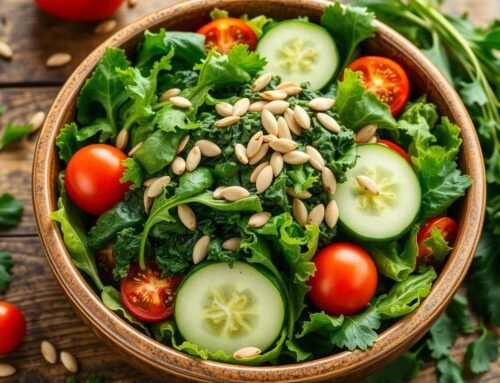
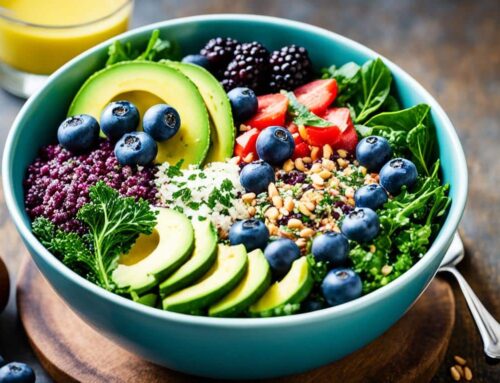
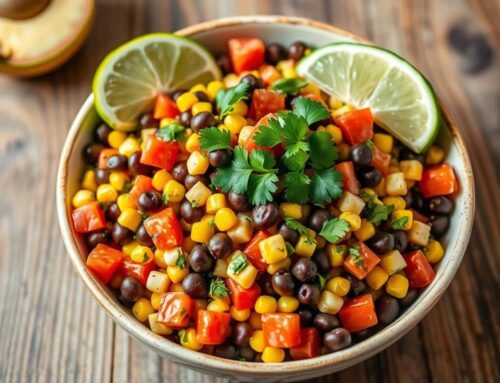
Leave A Comment